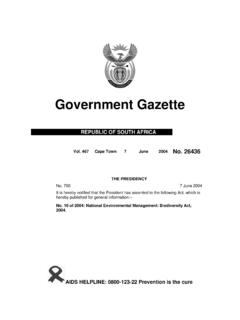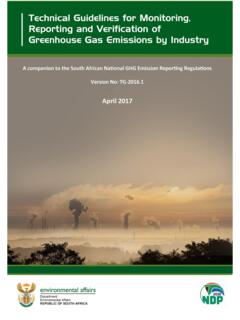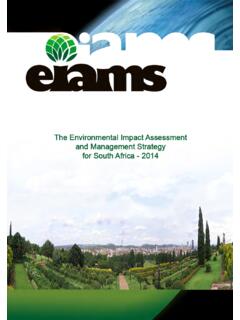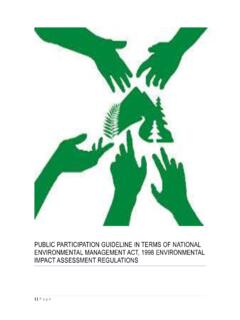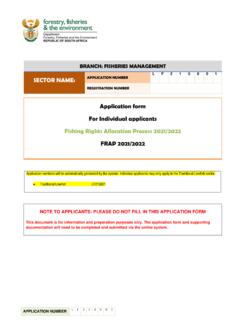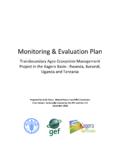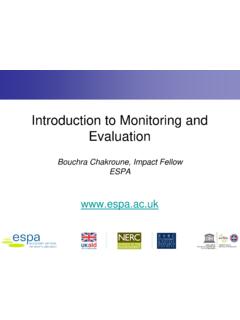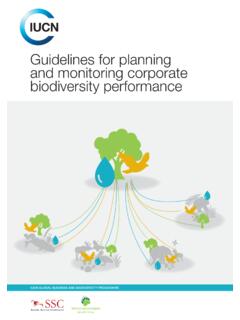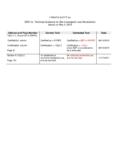Transcription of 6. Monitoring and Evaluation
1 6. Monitoring and BackgroundThis Chapter on Monitoring and Evaluation (M & E) system supports a coordinated approach to Monitoring and Evaluation in the Government Environmental Sector. The implementation of the system is intended to contribute towards the realisation of the Environment Sector Core focus area and priorities as outlined in the previous chapters. It is primarily aimed at enhancing the implementation of the Core focus areas and Strategic priorities for the Environmental Sector 2009-2014, through both Monitoring and Evaluation . At the core of the M & E system is a drive for learning from practice for more effective results. The strategic value of Monitoring and Evaluation towards the realisation of national priorities is underscored in South Africa s third developmental phase since 1994. Key to ensuring the realisation of strategic priorities is Monitoring and Evaluation because, used appropriately, M & E can increase individual, institutional, local, provincial and national performance, delivery and impact.
2 The Environment Strategic PrioritiesThe strategic direction of the environmental sector is underpinned by the country s sustainable development vision, which is: South Africa aspires to be a sustainable, economically prosperous and self-reliant nation state that safeguards its democracy by meeting the fundamental human needs of its people, by managing its limited ecological resources responsibly for current and future generations, and by advancing efficient and effective integrated planning and governance through national, regional and global collaboration (DEAT, 2008, p. 8).This M & E framework is informed by what is discussed in the core key deliverables on the previous chapters and it seeks to provide comprehensive and coherent mechanisms for Monitoring progress towards priorities using performance indicators derived from the priorities and goals. This M & E system provides mechanisms for evaluating achievements and impact of the Strategic goals against the indicators.
3 Monitoring and Evaluation is intended to cause changes and improvements in programmes, structures and methods of implementing the Strategic goals and priorities. This framework covers all three spheres of the Government of South Africa, namely, the National, Provincial and Local. The four main pillars that the vision of the environment sector wishes to achieve are:People s quality of life and daily living and working environments; The integration of economic development, social justice and environmental sustainability;The conservation and sustainable use of biological diversity; and Public participation in environmental governance. The Three Sustainable Development PrinciplesThe Environment Sector is also underpinned by three orders of sustainable development principles which have been taken into account in developing this chapter of M & E system (Table 9).9 DEAT. (2008). People, planet and prosperity: A national framework for Sustainable Development in South Africa.
4 DEAT: Pretoria67 Strategic Plan for Environmental Sector 2009 - 2014 Strategic Plan for Environmental Sector 2009 - 20146867 Strategic Plan for Environmental Sector 2009 - 2014 Strategic Plan for Environmental Sector 2009 - 2014 Table 2: South Africa s Sustainable Development PrinciplesOrder of principleGreen Economy First order principles - Fundamental human rights that are guaranteed in the ConstitutionHuman dignity and social equityJustice and fairnessDemocratic governanceSubstantive principles The conditions that must be met in order to achieve a sustainable society and are based on existing policies and legislation and underpin a cyclical and systems approachEfficient and sustainable use of natural resourcesSocio-economic systems that are embedded with and dependent upon ecosystemsBasic human needs must be met in a way that ensures that resources necessary for long-term survival are not destroyed for short term gainProcess principles Refer to how the National Strategic Framework for Sustainable Development should be implementedIntegration and innovationConsultation and participationImplementation in a phased mannerSource.
5 DEAT National Framework for Sustainable Development, Government-wide Monitoring and Evaluation StrategyIn addition to the Environmental Sector priorities and the Sustainable Development Principles, this M & E Framework is shaped by the Government-wide Monitoring and Evaluation Strategy (GWME), which was built on the World Bank Monitoring and Evaluation model. The Presidency has made it a requirement for each public entity to establish a Monitoring and Evaluation system: It is a statutory requirement that the accounting officer of a department or municipality, or the chief executive officer of a public entity is required to establish a Monitoring and Evaluation system for the institution (The Presidency, 2007, p. 4). The principles of the GMWE, which underpin this M & E framework, are to:Link relevant prior and ongoing government reforms and initiatives. Incorporate and consolidate existing Monitoring and Evaluation systems at national, provincial and local levels;Clearly defined and link roles and responsibilities of each stakeholder to their mandate;Link implementation plan to existing capacity and the ability to build capacity in the medium term;Facilitate the integration and inter-operability in government; Monitor and enforce statistical standards as important pre-conditions for effective Evaluation ; andRegularly review of the government Monitoring and Evaluation plan for its Best M & E Practice in the Public SectorThe fourth dimension of influence for this M & E system is best practices in government Monitoring and Evaluation elsewhere in different parts of the world.
6 World Bank assisted or evaluated government M & E systems offer the following lessons for this system:It is important to first diagnose the existing Monitoring and Evaluation systems, and to then build on process of establishing a comprehensive M & E Evaluation must have a capable champion, who is in a central position to drive the process. This can be a unit in the case of a M & E system should not be over-engineered but stick to the M & E system will work well if supported by strong information management indicators are an important dimension of good Monitoring and Evaluation . In addition, it is critical is to understand why a certain level of performance has been achieved or not should accompany the introduction of M&E framework in order to ensure utilisation of Monitoring and Evaluation success of an M & E system is largely determined by the extent to which the results of the Monitoring and Evaluation are used to improve performance and determinants of such M & E system itself should also be regularly reviewed for DEAT.
7 (2008) Strategic Plan for the Environment Sector 2008-2013. DEAT: The Presidency. (2007). Republic of South Africa. Policy framework for the government-wide Monitoring and Evaluation and legal requirements to conduct Monitoring and Evaluation have limited good M & E system should be accompanied by structural arrangements that ensure objectivity and quality by paying attention to such matters as:Role definition that ensures credibility, objectivity and quality in Monitoring -and Evaluation ;Clarity on who is to be responsible for planning, carrying out and using -evaluations;Whether self-evaluations or individual evaluations (or both); -Determining how much Monitoring and Evaluation is adequate; -Provision for continuous review and change of the M & E system; -Making adequate provisions for the funding of M and -Ensuring that there are linkages with other information systems in several country experiences ( Chile and Australia) three main factors have been identified as determining the success of an M&E system, namely:Intensive utilisation of Monitoring and Evaluation results, which suggests the mainstreaming of M&E;The provision of good quality information and evidence which forms the basis for sound decision-making at various layers.
8 The is informed by the quality of M & E systems and that of evaluations conducted; andSustainability of the system in spite of changes in administration, ministers and top government officials, which also tends to happen when there has been strong buy-in and an institutionalisation of the practice. A fourth lesson appears to be around provision for negotiating the Evaluation findings between the commissioning organisation/unit and the evaluated units, and the planning together for the following year s The Process of Developing this M & E FrameworkIt could have been fruitless to have the strategic goals and priorities for the next five years without developing M&E framework that will evaluate the extend and magnitude of government intervention to address environmental challenges. The process of developing and designing this M&E framework followed the following stages:The identification of core focuses areas and strategic goals and priority clustering of strategic goals into manageable units and numbers.
9 The development of indicators for each cluster of strategic goals by representatives from environmental sub-sectors, three spheres of government, NGOs and socialisation and testing of the M&E system among key stakeholders to elicit further improvements and ensure that they knew the tool that was to be used for Monitoring and evaluating their Strategic adoption of the M&E system by respective stakeholders and its incorporation into their institutional work plans and process of developing the performance and impact indicators, to focus and facilitate Monitoring and Evaluation heavily drew on input from stakeholders of the sector who came from relevant disciplines, all spheres of government Components of the M & E SystemA Monitoring and Evaluation system is a set of organisational structures, management processes, standards, strategies, plans, indicators, information systems, reporting lines and accountability relationships which enables national and provincial departments, municipalities and other institutions to discharge their M&E functions effectively.
10 In addition to these formal managerial elements are the organisational culture, capacity and other enabling conditions which will determine whether the feedback from the M&E function influence the organisation s decision-making, learning and service delivery (The Presidency, 2007: 4).Government Monitoring and Evaluation systems elsewhere suggest that a good M & E system improves accountability (value for money, good practice, audit follow up), governance (participation and transparency), public sector management (policy implementation and performance management), and financial management 69 Strategic Plan for Environmental Sector 2009 - 2014 Strategic Plan for Environmental Sector 2009 - 20147069 Strategic Plan for Environmental Sector 2009 - 2014 Strategic Plan for Environmental Sector 2009 - 2014(budgetexecution and expenditure quality). Monitoring prevents build up of errors. In short the use of an M & E system in government is likely to foster and performance orientation and approach to work, as units and branches relate their plans to outputs, outcomes and budgets more consciously.

